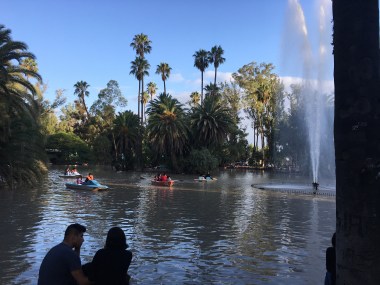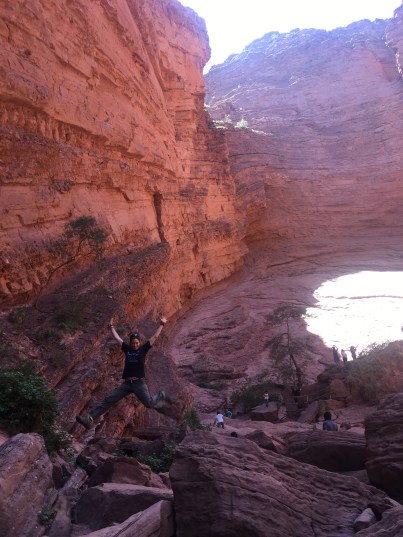It was in Chos Malal that my destiny with Liliana and Edgardo began.

Edgardo is a doctor and Liliana an accountant and a life coach. They also have a construction business (and no, I have no idea if they ever sleep). One day, they decided that they were going to quit their jobs and travel for a month. So they headed off in their pick-up truck from San Juan to begin their journey through the Patagonia in Argentina and Chile.
As they were telling me about their decision, they called themselves crazy for taking such a risk, for deciding to embark on this adventure. I asked them why they thought they were crazy – did their kids and other family members call them crazy? They thought about it and replied that no, no one else had called them crazy. Then, in sync, they both said, “we call ourselves crazy”. They laughed at their surprising synchronized response and then high-fived each other. And I thought to myself, “I like these people.”

They let me join them on their way to the lakes region where they would head off to cross into Chile. (They later confided that they had been kind of nervous to give a ride to a stranger; it was very much out of their normal comfort zone. I guess that in the same way that my travels have opened my mind and led me to step out of my comfort zone and into new experiences, it had done the same for them.)
We weren’t strangers for long. On the ride, they shared some of their favorite music and presented me with the theme song of my journey “Ruta 40″ by La Renga. They then continued to introduce me to the cornerstones of “rock nacional” or Argentina rock (G.I.T., Charly Garcia, Fito Páez, Soda Estereo), and a range of other music that they love (Alejandro Sanz, Los Pericos, Pablo Alborán, Jorge Drexler, Joan Manuel Serrat, and Silvio Rodriguez). The experience reminded me how music can be such a uniting part of culture and people’s personal stories, and how powerful it is when people can connect over it and share it.*
When we parted ways, I was left with a reminder to follow my dreams, invest in things that that I’m interested in, and not let myself be fettered to the idea of maximizing my income or savings. And to not be afraid to sometimes just see where the road takes me.
It was sad to see them go, but it turns out that that was not the last I saw of them. Later, I saw them pass by in their truck when I was in Villa La Angostura! They honked and waved and we caught up by text message later. Then, a few days later, I was hiking through a park in Bariloche, lost in thought, when… who do I run into? Edgardo and Liliana! I have to point out here that there are countless places to go hiking in and around Bariloche, so it was quite a coincidence to run into them for a THIRD time during our travels! We took that as a sign that we were destined to be friends and so we have stayed in touch.**

I parted ways with Liliana and Edgardo in the gorgeous area of “Junin de los Andes” and “San Martin de los Andes”. This is the beginning of the stretch of La Ruta 40 called “Camino de los Siete Lagos” or “Seven Lakes Route”, which starts in San Martín de los Andes and ends in Villa la Angostura. (Though one continues to see beautiful lakes as you continue past Villa la Angostura to Bariloche and on towards El Bolsón!)

It was here, outside of San Martin de los Andes, where I stayed in one of the most gorgeous spots of my trip – along one of those incredible lakes, Lago Faulkner. The weather was perfect – the sun was still strong enough to warm you up during the day, but it got quite chilly at night. And the wind!!! I always heard the wind in the Patagonia was strong. I don’t know if it was just this day or just this particular area, but the wind didn’t just blow, it whipped by! Walking along the lake, there were parts where the wind died down, but where the wind blew across the lake, it made waves as big as you could see on an ocean shore.

When the sun was shining strongly on the area of the lake where the trees blocked the wind, I took time to jump in the lake and go for a swim. Yep, it was freezing. I was glad those “polar bear swims” in Girl Scouts had prepared me for this. But once I was in, it felt good and I swam around for about 20 minutes, enjoying the crystal clear water and surprised every time the waves would lap me in the face.

Oscar, a former policeman who now helped look over some properties in the area, took me hiking around one lake and told me stories of some of the characters that he had met around the area. Many people come through and camp around the lake, but he had once even seen someone who came and stayed for more than a year, supposedly writing or working on some creative project. He also once came across a very unprepared camper who was freezing in her tent and he quite possibly saved her life by giving her a warmer place to stay. One of my favorite discoveries was that in one of the properties he took care of, there were some sculptures by a famous Argentine artist that worked with recycled materials.
The culture of the area kind of reminded me of the rural part of Texas where I grew up half-time, in that it has a big outdoors culture – fishing, hunting, hiking, camping, and watching shows like National Geographic and “Naked and Afraid”. I also met a modern day “gaucho” here. He was riding a horse to go check on his land and his animals.

The place where I stayed was literally off the grid. It got its electricity from a water turbine generator that was powered by water piped down to the house from high up in the nearby hills.

In my travels so far, I had heard multiple times about the popular drink Fernet and Coke that had originated in the city of Cordoba, but was popular throughout the country. Finally I had my chance to try it with Oscar. Fernet is a grape-based spirit made with a mixture of a variety of herbs. It naturally has a bitter flavor, which is probably why they mix it with Coke. Originally from Italy, it was brought over by the great Italian immigration to Argentina in the early 1900s and is so popular here that they built a distillery in the country, and Argentina accounts for 75% of the world-wide consumption. Since Fernet is basically the unofficial official drink of Argentina, I had to try it.

 Oscar also introduced me to the card game “escoba” (“broom”), which uses a Spanish deck of cards similar to the traditional poker deck… but completely different. It does not include the 8, 9 and 10 cards, so the jack is worth 8 (though it is marked with a “10”), there’s a horse worth 9 (though it is marked with an “11”), and the king is worth 10 (though it is marked with a “12”). To score points, you then have to make hands that add up to 15, remembering that some cards aren’t actually worth their face value. In conclusion, it is really confusing and challenging (but fun).
Oscar also introduced me to the card game “escoba” (“broom”), which uses a Spanish deck of cards similar to the traditional poker deck… but completely different. It does not include the 8, 9 and 10 cards, so the jack is worth 8 (though it is marked with a “10”), there’s a horse worth 9 (though it is marked with an “11”), and the king is worth 10 (though it is marked with a “12”). To score points, you then have to make hands that add up to 15, remembering that some cards aren’t actually worth their face value. In conclusion, it is really confusing and challenging (but fun).
Speaking of confusing, that night there was an important Argentina fútbol (soccer) moment, that I only kind of understand. There were two important matches that would determine the champion of the Argentina Superliga Tournament. (Which is not to be confused with the Copa de la Superliga, which follows this tournament.) There are many fútbol clubs in Argentina, but the two most famous, with the longest history and the most fans across the nation are Boca Juniors and River Plate (pronounced “Ree-bear”). We watched the River game (Oscar’s preferred team), and unfortunately they tied, giving the championship to Boca Juniors.
The next day, I did yoga surrounded by incredible hills and crystal clear lakes before saying my goodbyes to the lakes region and my new friend Oscar and heading off to Bariloche.

Famous Footnotes:
*For you music lovers, I threw in a few links for you to have a taste of the soundtrack of our journey together. (Hopefully sharing this music with you makes up for my failure to be able to share music with them since I had been reserving the space on my phone for photos. Note to self for future trips: Take at least a few of my favorite songs along, especially if they’re somewhat representative of American culture (whatever that means!))
**(They had been able to cross into Chile and see part of the “Carretera Austral”, but their trip got cut short (like all of us) in mid-March, and they had to return back to San Juan, where they are now safe and sound, riding out the physical isolation measures, like the all of us.




































































































